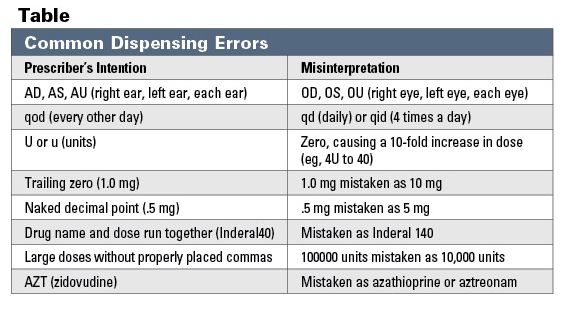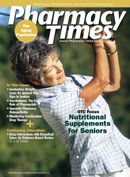Publication
Article
Pharmacy Times
10 Strategies for Minimizing Dispensing Errors
Author(s):
Dispensing errors can be costly for the pharmacist as well as potentially dangerous for the patient. Pharmacists can take simple steps to help eliminate this problem.
Mrs. Nair and Ms. Kappil are both PharmD candidates at the University of Florida Working Professional Doctor of Pharmacy Program. Dr. Woods is a clinical assistant professor at the University of Wyoming School of Pharmacy, Laramie.
Medication errors are a leading cause of mortality in the United States.1 Dispensing errors account for ~21% of all medication errors.2 In addition to causing serious morbidity and mortality, dispensing errors increase the economic burden on society by adding to health care costs. Faulty dispensing may also result in litigation, which can be expensive and lead to increased costs for professional liability insurance coverage. Dispensing in error is traumatic for the pharmacist as well as the patient; therefore, the goal of every pharmacy is to reduce the amount of dispensing errors. Fortunately, only about two thirds of dispensing errors reported actually reach the patient, with relatively few causing harm.2
Dispensing errors include any inconsistencies or deviations from the prescription order, such as dispensing the incorrect drug, dose, dosage form, wrong quantity, or inappropriate, incorrect, or inadequate labeling.3 Also, confusing or inadequate directions for use, incorrect or inappropriate preparation, packaging, or storage of medication prior to dispensing are considered to be errors.3 Errors occur at a rate of 4 per day in a pharmacy filling 250 prescriptions daily, which amounts to an estimated 51.5 million errors out of 3 billion prescriptions filled annually nationwide.4
Dispensing errors committed by individuals are often the result of error-prone systems and processes.5 Therefore, the main strategy to reduce dispensing errors is to implement a systemoriented approach rather than a punitive approach targeted at an individual. The following is a list of strategies for minimizing dispensing errors:
1. Ensure correct entry of the prescription.
Transcription errors (eg, omissions, inaccuracies) account for ~15% of all dispensing errors.6 These errors can be reduced by consistently using reliable methods to verify patient identity while entering the prescription into the computer. The Joint Commission requires that at least 2 patient identifiers be used for administering medications in a hospital setting. This strategy helps prevent medication errors due to sound-alike, look-alike names. At this point in the process, it is also useful to have information about the patient, such as the age of the patient, allergies, concomitant medications, contraindications, therapeutic duplications, and the like.
2. Confirm that the prescription is correct and complete.
Pharmacists’ “second guessing” of illegible and/or ambiguous prescriptions, nonstandard abbreviations, acronyms, decimals, and call-in prescriptions are frequently associated with medication errors.6 Whenever in question, it is important to call the prescriber to clarify any uncertainties or doubts regarding the prescription. Clarification obtained from the physician should be promptly documented. All verbal prescriptions should be immediately transcribed to a blank prescription pad and read back to the caller to ensure that the prescription has been transcribed correctly.
3. Beware of look-alike, soundalike drugs.
Similar drug names account for one third of medication errors. These types of errors are attributed to confirmation bias7—a tendency to interpret information in a way that confirms one’s preconceptions and avoids information and interpretations that contradict prior beliefs. As an example, a new, unfamiliar drug may be read as an older, more familiar one. Some of these errors can be fatal (eg, prescribing methadone instead of methylphenidate to an 8-year-old child).8 Such errors can be reduced by placing reminders on the stock bottle or in the computer system to alert staff about these commonly confused drug names.9
4. Be careful with zeros and abbreviations.
Misplaced zeros, decimal points, and faulty units are common causes of medication errors due to misinterpretation. 10 A transcription or interpretation error involving a zero or a decimal point means that the patient may receive at least 10 times more medication than indicated, which can result in serious consequences (eg, levothyroxine, warfarin). 11 These errors may be prevented by using computer alerts or by stocking a single strength of the medication in the pharmacy. These errors may be detected when reviewing the label directions during patient counseling. The Institute for Safe Medication Practices (ISMP) offers a list of error-prone abbreviations, symbols, and dose designations (a brief list of common dispensing errors is given in the Table). Being familiar with this type of information may also help prevent dispensing errors.12
5. Organize the workplace. Organizing work space, work environment, and workflow has been shown to markedly reduce dispensing errors. Proper lighting, adequate counter space, and comfortable temperature and humidity can help facilitate a smooth flow from one task to the next, thus reducing the chances of dispensing errors.11 Developing a routine for entering, filling, and checking prescriptions will help in organizing the flow of work. In addition, working with one drug product at a time and affixing the label to the patient’s prescription container before working on the next prescription will help prevent mix-ups. It is also important not to leave any drug containers unlabeled.
6. Reduce distraction when possible.
Multitasking and distraction during work is the leading cause of dispensing errors.2 Automatic-refill requests can reduce some of the distractions and thereby reduce dispensing errors. Also, having pharmacy technicians assist the pharmacists by performing routine functions will help minimize distractions. Although the extent to which distraction at work contributes to cognitive error is unclear, recent studies suggest that perception of dispensing errors by pharmacists is influenced by factors such as design of workflow, window services, and automatic dispensing.3 It must therefore be the goal of each pharmacy to improve the internal environment, even at the cost of patient convenience, in order to reduce medication errors.
7. Focus on reducing stress and balancing heavy workloads.
Workload increase is often cited as a contributing factor in dispensing errors.13 Sufficient staffing and appropriate workload will help reduce errors. Regular breaks and time off for meal breaks may help reduce some of the dispensing errors. Sharing responsibilities by clearly assigning duties to the staff will help them understand the expectations of the flow of work and may ultimately aid in reducing workplace stress, and, therefore, reduce medication errors.
8. Take the time to store drugs properly.
One way to avoid mix-ups among lookalike drugs is to store them away from each other in the medication storage area. Medication bottles should be properly organized with labels facing forward. It is also a good idea to routinely check all medications on the shelves and discard any expired medications. Use of storage bins, cabinets, or drawers can result in misplacement of look-alike drugs. It is also advisable to lock up or sequester drugs with high potential of causing errors.
9. Thoroughly check all prescriptions.
Repeated checking and counterchecking is an important strategy to minimize dispensing errors. Comparing the written prescription with the product that appears in the computer, with the label being printed, and with the medication that is being filled will help reduce errors. Confirmation bias and preconceived notions makes self-checking a poor method to reduce errors. Whenever possible, it is advisable to have the rechecking done by another person, typically a pharmacist. If this is not possible, delayed self-checking rather than continuous self-checking is an alternate strategy. 14 A delayed verification will allow the pharmacist to study the prescription from a fresh perspective, which will help in identifying the error that may not have caught his/her attention the first time the prescription was handled.
10. Always provide thorough patient counseling.
Approximately 83% of errors are discovered during counseling and are corrected before the patient leaves the pharmacy.15 Therefore, it is important to go beyond offering to counsel and provide counseling for each patient. It is considered good practice to open the container and show the actual medication to the patient during counseling rather than deliver it to the patient in a sealed bag. Completing this process will provide an opportunity for the patient to see the medication and ask questions if it looks different from what he or she has been taking.11 Counseling should also include the instructions on how to take the medication and appropriate route of administration. Many dispensing errors are attributed to misunderstood directions for use.11 Educating patients about safe and effective use of their medication promotes patient involvement in their health care, which will likely reduce medication errors.
The goal of every pharmacist is to minimize dispensing errors. Patient counseling being the last point of contact between the patient, pharmacist, and medication in the dispensing process is by far the most important strategy that every pharmacist must adopt in order to minimize dispensing errors. In addition, reporting errors as they occur and when they occur will help in learning from the mistakes and ultimately prevent such errors in the future. For further information, you may visit the ISMP Web site at www.ismp.org.

References:
1.
Kohn LT, Corrigan JM, Donaldson MSIoM (2000). To Err is Human: Building a Safer Health System (Washington D.C.: National Academy Press).
2.
Santell JP, Hicks RW, McMeekin J, Cousins DD. Medication errors: experience of the United States Pharmacopeia (USP) MEDMARX reporting system. J Clin Pharmacol. 2003; 43: 760-767.
3.
Szeinbach S, Seoane-Vazquez E, Parekh A, Herderick M. Dispensing errors in community pharmacy: perceived influence of sociotechnical factors. Int J Qual Health Care. 2007; 19: 203-209.
4.
Flynn EA, Barker KN, Carnahan BJ. National observational study of prescription dispensing accuracy and safety in 50 pharmacies. J Am Pharm Assoc. 2003; 43: 191-200.
5.
Leape LL, Bates DW, Cullen DJ, Cooper J, Demonaco HJ, Gallivan T, Hallisey R, Ives J, Laird N, Laffel G, et al. Systems analysis of adverse drug events. ADE Prevention Study Group. Jama. 1995; 274: 35-43.
6.
Hicks RW, Cousins DD, Williams RL. Selected medication-error data from USP's MEDMARX program for 2002. Am J Health Syst Pharm. 2004; 61: 993-1000.
7.
Davis NM. Combating confirmation bias. Am J Nurs. 1994; 94: 17.
8.
Drug name confusion, preventing medication error. FDA Consumer Magazine. July-August, 2005.
9.
Kelly K. Drug-Name Similarities and Dispensing Errors. Pharmacy Times. 2005; 71: 30-31.
10. Lilley LL, Guanci R. Careful with the zeros! How to minimize one of the most persistent causes of gross medication errors. Am J Nurs. 1997; 97: 14.
11. Cohen MR (2007). Medication Errors, 2 Edition (Washington, D.C.: American Pharmacist's Association).
12. Institute of Safe Medication Practices: www.ismp.org
13. Malone DC, Abarca J, Skrepnek GH, Murphy JE, Armstrong EP, Grizzle AJ, Rehfeld RA, Woosley RL. Pharmacist workload and pharmacy characteristics associated with the dispensing of potentially clinically important drug-drug interactions. Med Care. 2007; 45: 456-462.
14. Grasha A. A cognitive systems perspective on human performance in pharmacy: implications for accuracy, effectiveness and job satisfaction. Executive Summary Report. Alexandria, VA: National Association of Chain Drug Stores; October 2000. Report No. 062100.2000.
15. Ukens C. Deadly dispensing: an exclusive survey of Rx errors by pharmacists. Drug Topics. 1997; 100-111.







